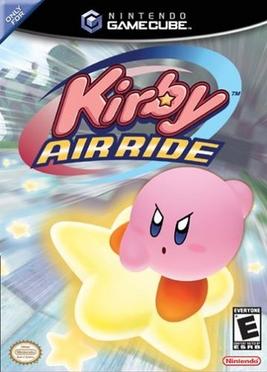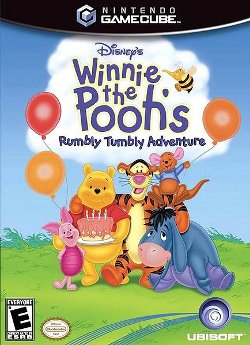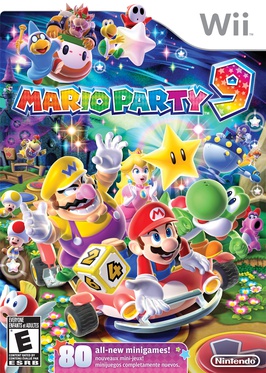
Mario Party 4 is a 2002 party video game developed by Hudson Soft and published by Nintendo for the GameCube. The game is the fourth installment in the Mario Party series and is the first game in the series to be released for the GameCube. Like the previous games in the series, it features eight playable characters: Mario, Luigi, Princess Peach, Yoshi, Wario, Donkey Kong, Princess Daisy, and Waluigi from the Mario franchise, who can be directed as characters on 6 themed game boards. The objective is to earn as many stars as possible, which are obtained by purchase from a single predefined space on the game board. Each character's movement is determined by a roll of a die, with a roll from each player forming a single turn. Each turn is followed by a minigame in which characters compete for coins they can use to purchase items and stars.

Mario Party 5 is a party video game developed by Hudson Soft and published by Nintendo for the GameCube. It is the fifth installment in the Mario Party series and the second game in the series to be released for the GameCube. It was first released in North America and Japan in November 2003, followed by Europe a month later. The game is set in the fictional Dream Depot, consisting of seven game boards. The single-player "Story" mode involves the player winning multiple games against the Koopa Kids to prevent Bowser from conquering the Dream Depot. The main multiplayer game mode consists of four characters from the Mario series playing a board game, with each board having a set theme. The game also features several minigames, which are played after every set of turns. Mario Party 5 introduces the "Super Duel" mode to the franchise, which requires players to assemble and control custom made battle vehicles which can be used in combat against other machines. The game features ten playable characters, with playable debuts to the series from Toad, Boo, and Koopa Kid.

Mario Kart: Double Dash!! is a 2003 kart racing video game developed and published by Nintendo for the GameCube (GCN). This game is the fourth main entry in the Mario Kart series, following Mario Kart: Super Circuit (2001), Mario Kart 64 (1996), and Super Mario Kart (1992). Similar to the previous titles, Double Dash!! challenges Mario series player characters to race against each other on Mario-themed tracks. The game introduced a number of new gameplay features, such as supporting co-op gameplay with two riders per kart. One player drives the kart and the other uses items, hence the game's title. Players can switch at any time. Double Dash!! is the only game in the Mario Kart series to allow cooperative gameplay so far. Double Dash!! supports LAN play using the Nintendo GameCube Broadband Adapter, allowing up to 16 players to compete simultaneously. There are 20 characters to select from in total, each of which with a special item, and with eleven characters being new to the series.

Mario Party is a party video game series featuring characters from the Mario franchise in which up to four local players or computer-controlled characters compete in a board game interspersed with minigames. The games are currently developed by NDcube and published by Nintendo, being previously developed by Hudson Soft. The series is known for its party game elements, including the often unpredictable multiplayer modes that allow play with up to four, and sometimes eight, human players or CPUs.

Soulcalibur II is a 2002 fighting game developed by Project Soul and published by Namco and the third installment in the Soulcalibur series of weapon-based fighting games. It is the sequel to Soulcalibur, which was released in July 1998. Originally intended to be released on Sega's NAOMI board, the game was released on the Namco System 246 arcade board before being ported to the PlayStation 2, GameCube, and Xbox in 2003.

Kirby Air Ride is a 2003 racing video game starring Kirby, developed by HAL Laboratory and published by Nintendo for the GameCube.

1080° Avalanche is a snowboarding video game for the GameCube, developed by Nintendo's in-house development studio, Nintendo Software Technology, and published by Nintendo. It was released in 2003 in Europe and North America, and in Japan on January 22, 2004. Avalanche is a sequel to the 1998 video game 1080° Snowboarding for the Nintendo 64.

Crash Bash is a 2000 party video game developed by Eurocom Entertainment Software in association with Cerny Games and published by Sony Computer Entertainment for the PlayStation. It is the fifth title in the Crash Bandicoot series and the first in the party genre. The game includes a collection of 28 mini-games playable within three modes of gameplay, as well as eight playable characters from the Crash Bandicoot series.

Dragon Ball Z: Budokai, released as Dragon Ball Z in Japan, is a fighting video game developed by Dimps for PlayStation 2 release in 2002 and GameCube release in 2003. The first game in the Dragon Ball Z: Budokai series, it is based on the Japanese anime series Dragon Ball Z, part of the manga franchise Dragon Ball. It was published in Japan by Bandai and in North America by Infogrames, and was the first console Dragon Ball video game in five years since Dragon Ball GT: Final Bout (1997).

Lego Star Wars: The Video Game is a 2005 Lego-themed action-adventure video game based on the Lego Star Wars line of construction toys, and the first installment in the Lego video game franchise developed by Traveller's Tales, which would develop all future Lego titles from that point on. It was first released on 29 March 2005, and is a video game adaptation of the Star Wars prequel trilogy: The Phantom Menace, Attack of the Clones and Revenge of the Sith, with a bonus level from A New Hope.

Burnout 2: Point of Impact is a 2002 racing video game developed by Criterion Games and published by Acclaim Entertainment for PlayStation 2, GameCube and Xbox. It is the sequel to the 2001 video game Burnout and the second title in the Burnout series. It was the last Burnout game to be released on the GameCube and the series would not see a release on a Nintendo platform until the release of Burnout Legends in 2005. The game also marked Acclaim's last entry in the Burnout series, as Acclaim would go bankrupt in 2004; the rest of the series would be published by Electronic Arts.

Mario Party 7 is a party video game developed by Hudson Soft and published by Nintendo for the GameCube in November 2005. The seventh main installment in the Mario Party series, it makes use of the microphone peripheral introduced in Mario Party 6, and features twelve characters, including two new unlockable characters: Birdo and Dry Bones. Koopa Kid was omitted as a playable character, after being playable in the two previous games.

SpongeBob SquarePants: Lights, Camera, Pants! is a video game based on the TV series SpongeBob SquarePants. It was released in October 2005 for the Xbox, PlayStation 2, GameCube, Game Boy Advance, and the PC. It is the first SpongeBob SquarePants title to feature multiplayer mini-games, similar to the Mario Party video game series.

Digimon Rumble Arena is a 2001 fighting video game developed and published by Bandai. It is part of a video game series connected to the Digimon franchise and showcases the titular creatures within the context of a fighting video game. The player controls one of several Digimon and engages in combat with other Digimon within a variety of settings. Apart from the central fighting gameplay, a trio of mini-games are available upon the single-player campaign's completion.

Super Monkey Ball Adventure is a platform video game developed by Traveller's Tales and published by Sega. Part of the Super Monkey Ball series, it was released on 2006 for the PlayStation 2, PlayStation Portable and GameCube.

Freaky Flyers is an air racing video game developed internally by Midway San Diego for the Xbox and PlayStation 2, while the version for the GameCube was developed by Point of View, Inc. and published by Midway.

Mary-Kate and Ashley: Sweet 16 - Licensed to Drive is a 2002 party video game published by Acclaim Entertainment under its Club Acclaim label. The game was released for the PlayStation 2, GameCube and Game Boy Advance. n-Space developed the game for the PS2 and GameCube whereas Powerhead Games developed the game for GBA.

Monsters, Inc. Scream Arena is a 2002 sports game developed by Radical Entertainment and published by THQ for the GameCube. The game is based on the 2001 film Monsters, Inc..

Winnie the Pooh's Rumbly Tumbly Adventure is a 2005 action-adventure game developed by French company Phoenix Studio and co-published by Ubisoft and Disney Interactive. Intended towards younger audiences, the game is based on the Disney version of the Winnie the Pooh character. The game was re-released as a PS2 Classic on the PlayStation Store in 2013.

Mario Party 9 is a 2012 party video game developed by NDcube and published by Nintendo for the Wii. The ninth main installment in the Mario Party series, it was announced at E3 2011 and released in Europe, North America, and Australia in March 2012, followed by Japan a month later. It was the first game in the series not to be developed by Hudson Soft, which was acquired and dissolved by Konami on March 1, 2012, the day before the game's European release. Instead, development was taken over by Nintendo studio NDCube. This was also the final Mario game to be released on the Wii.



















